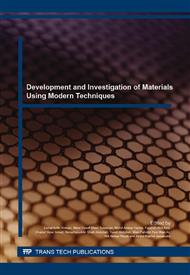p.299
p.305
p.309
p.315
p.321
p.326
p.331
p.336
p.343
Production of Stainless Steel 316L Foam with Different Solid Loading
Abstract:
Stainless steel foam has been used for various applications due to their advantages over other materials such as high corrosion resistance, easily availability, and low-cost as well as good mechanical properties. In this work, stainless foam was produced by using foam replication method with different solid loading of SS316L i.e 55 wt%, 60 wt%, 65 wt% and 70 wt% SS316L. The samples were sintered in a vacuum furnace at 1250°C. The sample microstructure was characterized by using scanning electron microscope (SEM) while the elemental component was analyzed by using Energy Dispersive X-ray (EDX). The Archimedes test has been conducted to determine the samples density and porosity. It was found that the best sample is SS316L foam with 65 wt% solid loading with the density and porosity of 1.85 g/cm3 and 76.84% respectively which are similar to the human bone. The sample also has open and interconnected pores.
Info:
Periodical:
Pages:
321-325
Citation:
Online since:
January 2016
Authors:
Price:
Сopyright:
© 2016 Trans Tech Publications Ltd. All Rights Reserved
Share:
Citation:


